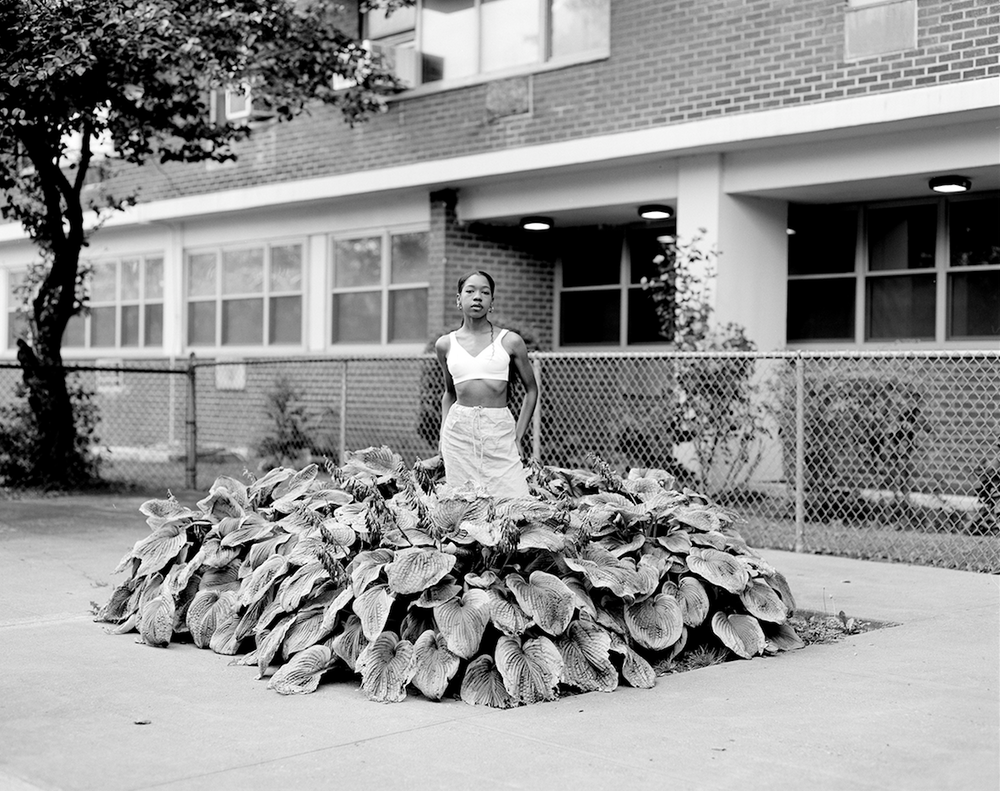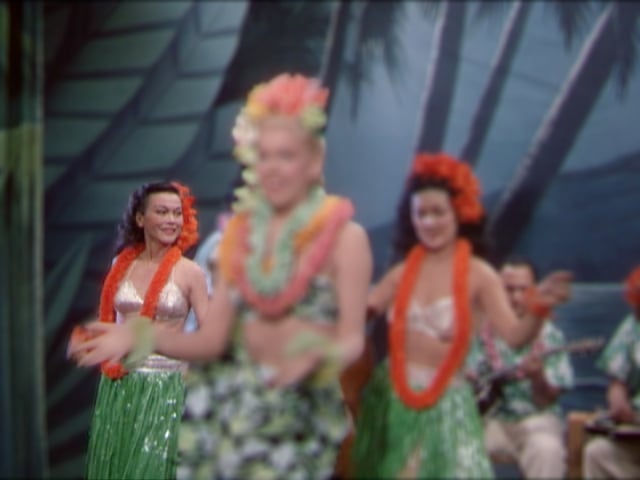
© » KADIST
Olga Grotova
Our Grandmothers’ Gardens by Olga Grotova is based on the history of Soviet allotment gardens, which were small plots of land distributed amongst the families of factory workers to compensate for poor food supply in a country that was over-producing weapons. Beginning in the 1960s, Grotova’s great grandmother and grandmother tended an allotment garden for three decades, after their release from an all-female gulag camp for “enemies of the people”. These camps detained wives, sisters, mothers, and daughters of men executed during Stalinist repressions.

© » KADIST
Hong Hao
Drawing & Print (Drawing & Print)
Selected Scripture is a series of silkscreen prints that Hong Hao has been working on since the 1980s. The series includes 37 prints to date, each of which resemble pages of an ancient open cartography book. In this series, the artist reflects on the authoritative influence of ancient books that shape dominant understandings of the world.

© » KADIST
Aline Baiana
Indigenous educator and curator Sandra Benites, of the Guarani-Ñandeva people, narrates the origin myth of the bird Urutau in her native language. This nightjar stands still on a branch all day long and, at dusk, cries a low hoot resembling a human weeping. In 2013, indigenous activist José Urutau Guajajara remained on the top of a tree for 26 hours, deprived of food and water by state forces.

© » KADIST
Olga Grotova
Our Grandmothers’ Gardens by Olga Grotova is based on the history of Soviet allotment gardens, which were small plots of land distributed amongst the families of factory workers to compensate for poor food supply in a country that was over-producing weapons. Beginning in the 1960s, Grotova’s great grandmother and grandmother tended an allotment garden for three decades, after their release from an all-female gulag camp for “enemies of the people”. These camps detained wives, sisters, mothers, and daughters of men executed during Stalinist repressions.

© » KADIST
Lieko Shiga
Lieko Shiga’s photographs appear like dreamscapes. They gain much of their visual power from the unusual interplay between light and color, and the way in which her motifs often seem to defy physical laws such as gravity. She often photographs nocturnal landscapes that are both enchanted and haunted, invoking an emotionally and psychologically complex, contemporary inner landscape, as well as the ancient relations between mysticism, spirituality, and folklore, specifically invoking Japanese traditions and beliefs, while at the same time transforming them.

© » KADIST
Lieko Shiga
Lieko Shiga’s photographs appear like dreamscapes. They gain much of their visual power from the unusual interplay between light and color, and the way in which her motifs often seem to defy physical laws such as gravity. She often photographs nocturnal landscapes that are both enchanted and haunted, invoking an emotionally and psychologically complex, contemporary inner landscape, as well as the ancient relations between mysticism, spirituality, and folklore, specifically invoking Japanese traditions and beliefs, while at the same time transforming them.
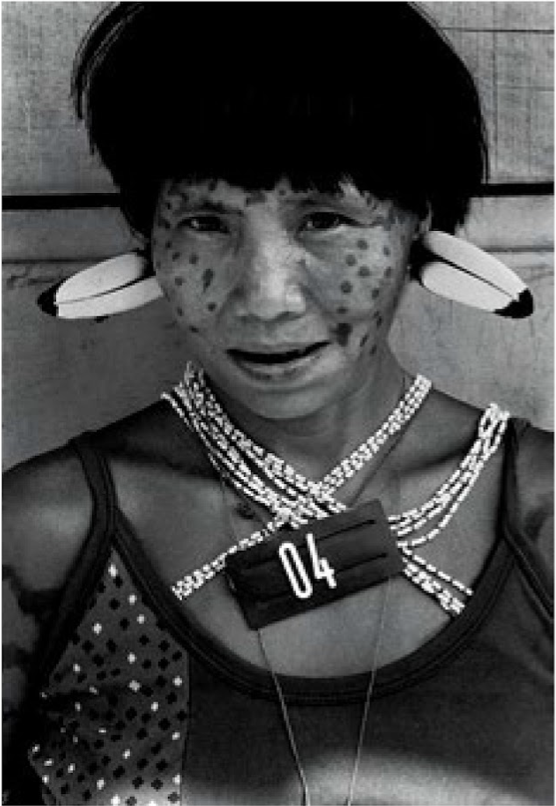
© » KADIST
Claudia Andujar
In 1980, with the construction of highways in Indigenous territories, an epidemic was brought to the Yanomami region. As the Yanomami do not have first names, it was necessary to give them numbers to indicate that they had already been vaccinated and identify each one for their medical records. From this series of events, Claudia Andujar’s Marcados series was born: what was supposed to be a mere photographic record, for organizational purposes, ended up raising a big question about the “labels” given to people in the construction of societies.

© » KADIST
davi de jesus do nascimento
Drawing & Print (Drawing & Print)
davi de jesus do nascimento’s earthy paintings, from the series sorvedouro , recall his memories as an essentially organic matter. Watercolor painting carries water as its foundational element and was the first technique that the artist applied to base his painting research on the river. He used to dip the brush on the prow of the boats: “I realized that the water is in deep dialogue with the flows of the river that I descend”.

© » KADIST
Claudia Andujar
In 1980, with the construction of highways in Indigenous territories, an epidemic was brought to the Yanomami region. As the Yanomami do not have first names, it was necessary to give them numbers to indicate that they had already been vaccinated and identify each one for their medical records. From this series of events, Claudia Andujar’s Marcados series was born: what was supposed to be a mere photographic record, for organizational purposes, ended up raising a big question about the “labels” given to people in the construction of societies.

© » KADIST
Olga Grotova
Our Grandmothers’ Gardens by Olga Grotova is based on the history of Soviet allotment gardens, which were small plots of land distributed amongst the families of factory workers to compensate for poor food supply in a country that was over-producing weapons. Beginning in the 1960s, Grotova’s great grandmother and grandmother tended an allotment garden for three decades, after their release from an all-female gulag camp for “enemies of the people”. These camps detained wives, sisters, mothers, and daughters of men executed during Stalinist repressions.

© » KADIST
Mary Helena Clark
The Dragon is the Frame by Mary Helena Clark is an elegy that is somewhat paradoxically organized as a film noir or murder mystery, one that pays direct homage to Hitchcock’s Vertigo . But the parts don’t fit, and it is only in the eventual recognition of this faux raccord that Clark’s higher purpose becomes apparent. As we hear Bernard Herrmann’s score, we see the Golden Gate Bridge, Mission Dolores, and other Vertigo locations in the present day.

© » KADIST
Claudia Andujar
In 1980, with the construction of highways in Indigenous territories, an epidemic was brought to the Yanomami region. As the Yanomami do not have first names, it was necessary to give them numbers to indicate that they had already been vaccinated and identify each one for their medical records. From this series of events, Claudia Andujar’s Marcados series was born: what was supposed to be a mere photographic record, for organizational purposes, ended up raising a big question about the “labels” given to people in the construction of societies.

© » KADIST
Miguel and Natalia Fernández de Castro and Mendoza
The Absolute Restoration of All Things is a collaboration by artist Miguel Fernández de Castro and anthropologist Natalia Mendoza. For this project, Fernández de Castro and Mendoza researched the 2014 court case that shut down Penmont Mining’s operations in the middle of the Sonoran desert. The lawsuit was brought to court by the “ejidatarios” (communal land holders) of El Bajío, Sonora, who claimed that their territory was illegally occupied and exploited, causing an irrevocable environmental impact on their land.

© » KADIST
Hong Hao
Drawing & Print (Drawing & Print)
Selected Scripture is a series of silkscreen prints that Hong Hao has been working on since the 1980s. The series includes 37 prints to date, each of which resemble the pages of an ancient cartography book. In this series, the artist reflects on the authoritative influence of ancient books that shape dominant understandings of the world.

© » KADIST
Claudia Andujar
In 1980, with the construction of highways in Indigenous territories, an epidemic was brought to the Yanomami region. As the Yanomami do not have first names, it was necessary to give them numbers to indicate that they had already been vaccinated and identify each one for their medical records. From this series of events, Claudia Andujar’s Marcados series was born: what was supposed to be a mere photographic record, for organizational purposes, ended up raising a big question about the “labels” given to people in the construction of societies.

© » KADIST
Elsa Werth
In the video Color Strip by Elsa Werth two-dimensional versions of all the national flags of the world (197 in all) are compiled into a long horizontal strip. The video is presented on a large flat-screen, approximating the size and dimensions of a national flag. As each flag slides across the screen, connections between the colors, signs, and forms of different countries and parts of the world create unexpected associations.

© » KADIST
Pratchaya Phinthong
Pratchaya Phinthong’s work has explored the mineral and karmic economies of Laos, a country that shares language, beliefs, and a long border with his own native region of Isaan (Northeast Thailand). The most bombed nation on earth, Laos still bears the physical and mental scars of the U. S. military’s epic aerial offensive, launched largely from bases in Isaan, during the Second Indochina War. Between 1964 and 1973 the US dropped an estimated 250 million cluster bombs on Laos.

© » KADIST
Hong Hao
Drawing & Print (Drawing & Print)
Selected Scripture is a series of silkscreen prints that Hong Hao has been working on since the 1980s. The series includes 37 prints to date, each of which resemble pages of an ancient open cartography book. In this series, the artist reflects on the authoritative influence of ancient books that shape dominant understandings of the world.

© » KADIST
Chia-Wei Hsu
The final work in the Marshal Tie Jia series (of which Turtle Island is in the KADIST collection), Spirit Writing features the Marshal in conversation with Chia-Wei Hsu, by way of a ritual involving the Marshal’s divination chair. Marshal Tie Jia is a frog god, who was born in a pond in Jiangxi, China, before fleeing to Matsu Island off the coast of Taiwan during the Cultural Revolution after his temple was destroyed. Spirit Writing attempts to reconstruct the original temple using 3D modeling software, operated in real time as Hsu asks the Marshal questions, receiving answers through a divination ritual in which the chair is swung violently around by his acolytes.

© » KADIST
Ana Vaz
Há Terra! (There Is Land!) is a short film by Ana Vaz that picks up on the artist’s previous film A Idade da Pedra (2013), in which Vaz imagined premodernity in her native Brazil.

© » KADIST
Sancintya Mohini Simpson
Dhuwã (term used by indentured people of Natal for ‘smoke’), is a single-channel film by Sancintya Mohini Simpson that traces back to the lived experiences of indentured labourers taken from India to Natal (now KwaZulu-Natal, South Africa) to work on sugar plantations during the late 1800s and early 1900s. This often-overlooked chapter in colonial history is close to the artist, as her maternal family were contracted to a sugar plantation in Natal. Filmed originally in 16mm film, Dhuwã captures sugarcane plantations in North Queensland, initially in moments of stillness that are gradually disrupted by a crescendo of repetitive sounds and fast camera movements that culminate in the fields being engulfed by flames.

© » KADIST
Maya Watanabe
In Escenarios (Sceneries) Maya Watanabe films forgotten wastelands through a series of 360° camera movements that highlight the dramatism and visual richness of terrain that would be otherwise forgotten. Her choice to depict these lands is a reference to the devastated geography that now grips her Peru after decades of destruction from a grueling Civil War—the second largest internal conflict in the history of Latin America. Through the videos of this post-conflict territory she alludes at once to the sombre episode in Peru’s recent history, as well as her memory of it: fragmented and contused.
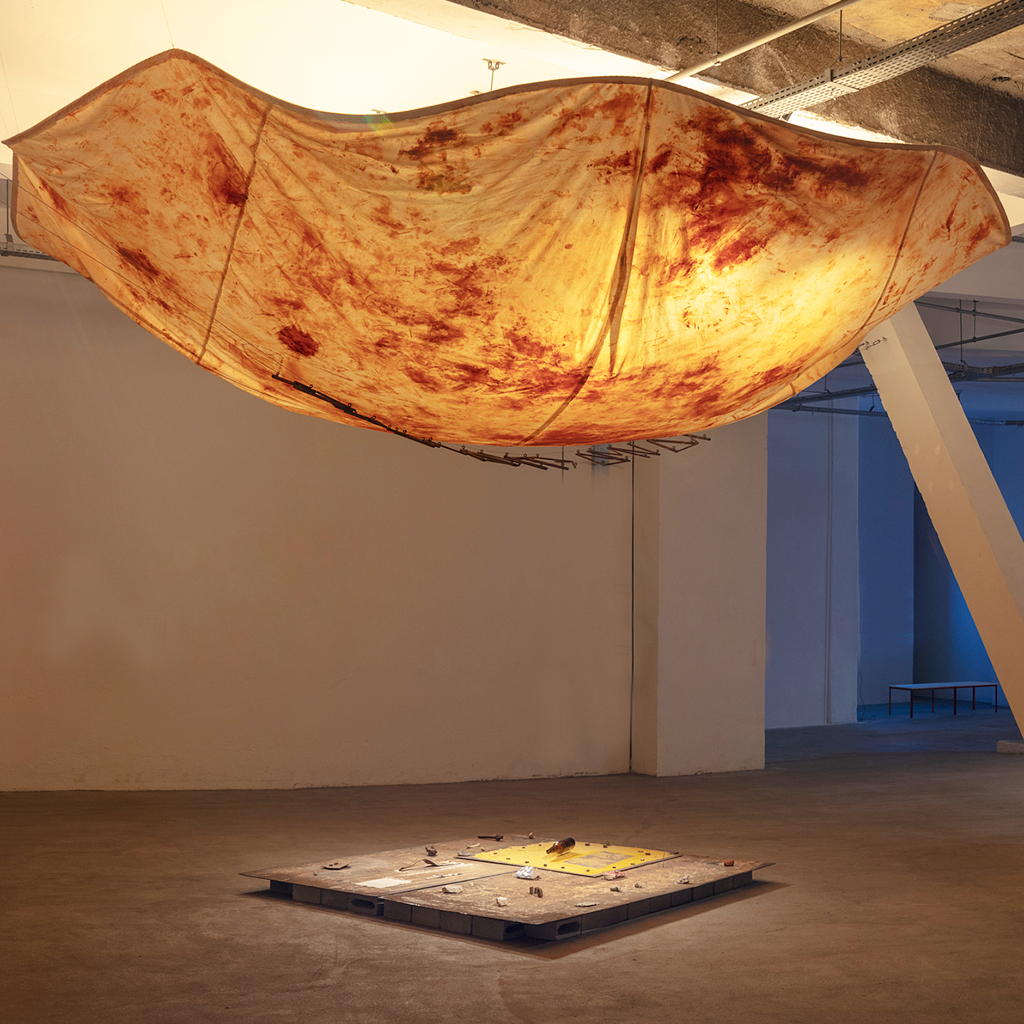
© » KADIST
arquivo mangue
o que diriam as pedras a marte? [What would the stones say to Mars?] is a sculptural work consisting of two parts by arquivo mangue.

© » KADIST
Richard Bell
For Richard Bell, art is not simply a vehicle through which to represent and convey political content. On one hand, art itself has an activist charge—in its very form and presence it can shake up conventional or assumed understandings, opinions, and behaviours. But on the other hand, it is deeply implicated in the actions and attitudes associated with colonialism in Australia and abroad.

© » KADIST
Edgar Calel
The point of departure for Xar – Sueño de obsidiana by Edgar Calel is a poem that the artist wrote in Maya Kaqchikel. Made in collaboration with Brazilian filmmaker Fernando Pereira dos Santos, the film was shot while in lockdown in Brazil, where Calel found himself during the first outbreak of the COVID-19 pandemic. The film shows Calel ambling around the empty Ciccillo Matarazzo Pavilion designed by Oscar Niemeyer to host the São Paulo Biennial in 1954.

© » KADIST
Mercedes Dorame
Mercedes Dorame utilizes photography to investigate, recode, and connect with her Gabrielino-Tongva tribe culture, as well as to bring current Indigenous experiences to light. The Tongva were the original inhabitants of what is now Los Angeles, and their domain stretched from Malibu to San Bernardino, including Aliso Creek. They have lived in the Los Angeles basin for over 8,000 years.

© » KADIST
Natalia Lassalle-Morillo
La Ruta by Natalia Lassalle-Morillo follows the Panoramic Route, a now weakened infrastructure that meanders through untouched natural landscapes and off-road destinations on the island of Puerto Rico. The Panoramic Route was designed for residents and tourists to connect with the traditional center of the island, as part of a political agenda to modernize the country through infrastructure and social programs. Today, the highway is notorious for dismal road conditions, resulting in isolation between more densely populated metropolitan areas and contributing to a loss of cultural sites and practices that once took place along the Route.
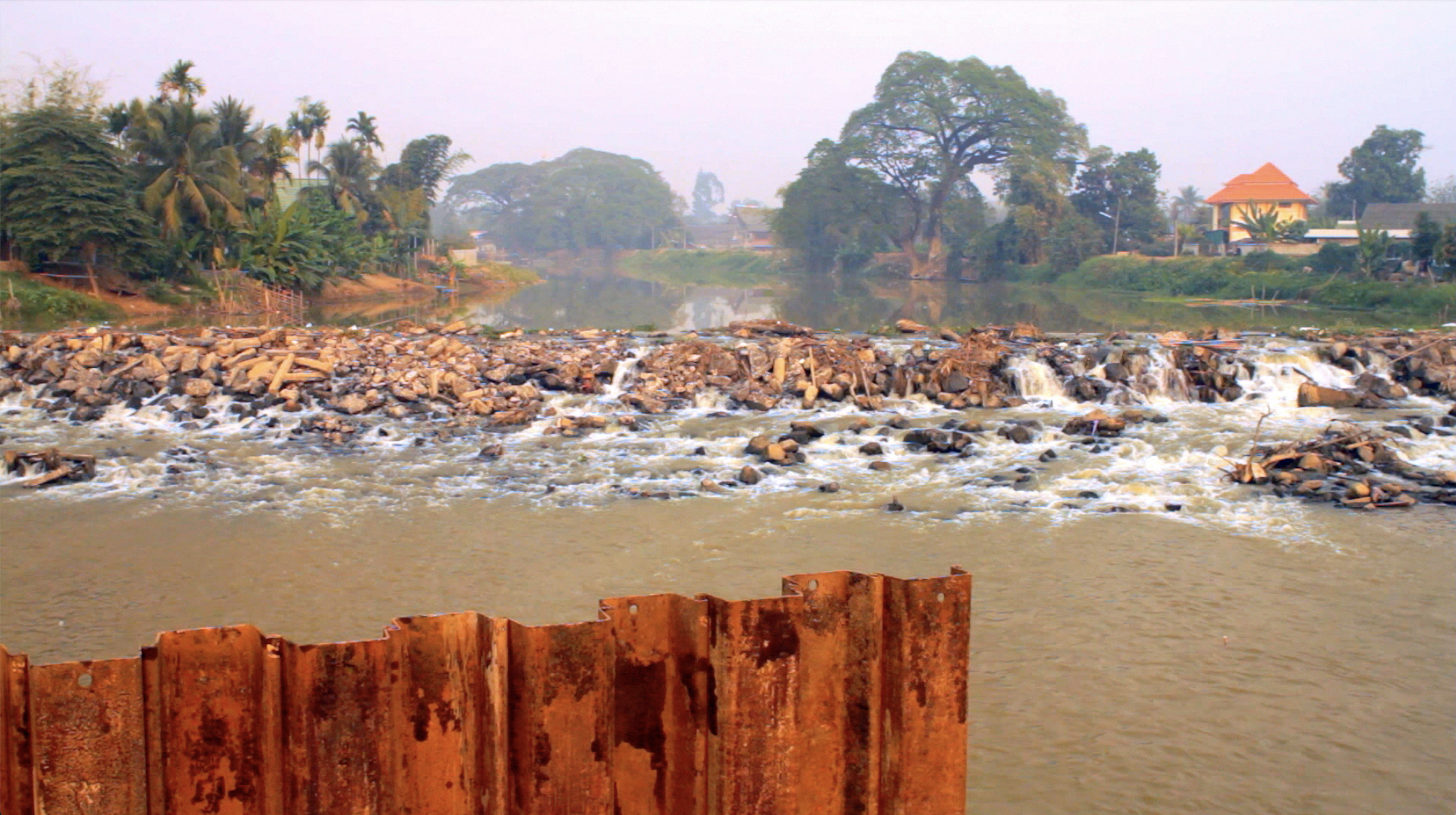
© » KADIST
Som Supaparinya
The flat, wide river holds on its surface a tour-boat of memories, as Som Supaparinya documents her Grandfather’s return via cruise to familiar territories in rural Thailand that were submerged after the Thai government installed a series of dams. An unsettling sense of trauma emerges from the absence of what is being described in My Grandpa’s Route has been Forever Blocked . Supaparinya’s juxtaposition of unceasing waterways and cruise life with a series of dams, obstinately responsible for these conditions.

© » KADIST
YOUNG-HAE CHANG HEAVY INDUSTRIES
The absurd condition of human survival under environmental degradation and geonational balkanization is taken as a starting point for WA’AD by YOUNG-HAE CHANG HEAVY INDUSTRIES. The work’s premise is a confessional narrative emerging from a Palestinian astronaut on a desperate international flight mission to colonize Mars. That there is also an Israeli astronaut on the same mission plays into the complexities of the landed history of ethnic antagonism between Israel and Palestine, which has stretched on for centuries.

© » KADIST
Khvay Samnang
Originally commissioned for documenta 14, Khvay Samnang’s two-channel video work Preah Kunlong (The way of the spirit) takes land politics, resource extraction and Indigenous Cambodian resistance as its primary concern. Created in collaboration with the classically-trained dancer and choreographer Nget Rady — who is also the performer in the video — Preah Kunlong powerfully utilizes a lexicon of gestures and movement to point toward the need for embodied forms of knowledge and understanding amidst the mechanistic frameworks of rapacious development, which are threatening not just forests and Indigenous communities in Southeast Asia, but also worldwide. More specifically, Preah Kunlong offers a proposal for the language of the body to exercise what political ecologist Nancy Lee Peluso has called “counter-mapping”, a form of “critical cartography” that has been practiced by Indigenous forest communities in Southeast Asia to strengthen claims on their traditional territories and resources by defying hegemonic mapmaking methods, which have long abetted strategies of colonial rule and resource extraction.
Claudia Andujar
Claudia Andujar was born in Switzerland in 1931, and then moved to Oradea, on the border between Romania and Hungary, where her paternal family, of Jewish origin, lived...
Olga Grotova
Olga Grotova is an artist and poet whose practice involves collecting and mapping stories of Soviet and Eastern-European women that have been erased from established historical narratives...
Hong Hao
Spanning photography, painting, installation, as well as behavior and performance art, Hong Hao’s artistic exploration is informed by the many cultural, political, and economic shifts in his lifetime...
Lieko Shiga
Based on an instinctive feeling of unease with the convenience and automation of daily life, Lieko Shiga has developed an artistic approach that links questions about the nature of the photographic medium with fundamental questions about life and the means of expressing oneself...
Paul Kos
- location: San Francisco, California
- year born: 1942
- gender: male
- nationality: American
Khvay Samnang
Khvay Samnang’s work critically examines the interlocking nature of ritual and politics, the humanitarian and ecological impacts of globalization, colonialism and migration, and the cultural-material histories of exchange that have shaped the Southeast Asia region...
Mary Helena Clark
Mary Helena Clark is an artist working in film, video, and installation...
Jakrawal Nilthamrong
Jakrawal Nilthamrong is a Thai artist and filmmaker who came to prominence for his unconventional approach to filmmaking...
Liu Yu
Liu Yu has developed a multifaceted artistic practice that takes field documentation as its point of departure...
Aline Baiana
Aline Baiana’s work is informed by extensive theoretical and field research on indigenous, feminist, ethnic, environmental, and social justice matters...
Tessa Mars
Tessa Mars delves into Haitian history, her primary source of inspiration, to unveil a colourful and provocative universe that she wishes to reclaim...
Ana Vaz
Ana Vaz is an artist and filmmaker whose works speculate on the relationships between self and other, and myth and history, through a cosmology of signs, references, and perspectives...
YOUNG-HAE CHANG HEAVY INDUSTRIES
YOUNG-HAE CHANG HEAVY INDUSTRIES, a partnership between the South Korean artist Young Hae Chang and the American poet Mark Voge, is widely known as a pioneering net art project...
Som Supaparinya
Humanity is not ontologically transcendent, artist Som Supaparinya’s work makes adamantly clear: actions energetically create impacts, experience dictated not only by our perceptions but equally the world that surrounds us, tethered inextricably...
Pratchaya Phinthong
Pratchaya Phintong’s works often arise from the confrontation between different social, economic, or geographical systems...
Sancintya Mohini Simpson
Sancintya Mohini Simpson is an artist, writer, and researcher whose work addresses the impact of colonization on the historical and lived experiences of her family and broader diasporic communities...
arquivo mangue
arquivo mangue is the artistic duo of Camila Mota and Cafira Zoé, who consider their collective as a tool that witnesses the course and evolution of cosmogonies...
Mercedes Dorame
Mercedes Dorame is a photographer and member of the Tongva tribe in Los Angeles...
Richard Bell
Richard Bell works across a variety of media including painting, installation, performance and video and text to pose provocative, complex, and humorous challenges to our preconceived ideas of Aboriginal art, as well as addressing contemporary debates around identity, place, and politics...
Edgar Calel
Edgar Calel is a Maya Kaqchikel artist and poet from the midwestern highlands of Guatemala...
Chia-Wei Hsu
Embarking from myriad audio-visual narratives, Chia-Wei Hsu pursues imaginative interrogations of cultural contact and colonization in Asia, oftentimes amalgamating his primary narratives with non-human actors including technologies, animals, gods, environments, traditions, and material objects...
Chanell Stone
Chanell Stone’s practice explores what she describes as the “re-naturing” of the Black body to the American landscape—an act that aims to complicate and sublimate the history of American slavery into a reimagined relationship between African Americans and the earth...
Maya Watanabe
Drawing on her background in theater design and direction, Maya Watanabe is known for her multi-channel video installations that explore the relationship between language, collectivity, identity, and space...
Natalia Lassalle-Morillo
Natalia Lassalle-Morillo’s films explore familial, neighborly, and citizen relationships in the context of Puerto Rico’s fraught history with the United States and the resulting imperialist oppression that has altered generations of families’ material and spiritual trajectories...
Miljohn Ruperto
- location: Los Angeles, California
- year born: 1973
- gender: male
- nationality: Filipino and Danish
- home town: Manila, Philippines
Elsa Werth
Through an economy of means, Elsa Werth makes purposefully non-spectacular gestures as forms of resistance, disruption, and transformation...
Enrique Ramirez
- year born: 1979
- gender: male
- nationality: Chilean
- home town: Santiago, Chile
davi de jesus do nascimento
davi de jesus do nascimento grew up in Pirapora, a town in the north of Minas Gerais, which guides the narratives of his work, as does the heritage of his family of fishermen, laundresses, and Carranca masters...
-
1970-1979
-
1980-1989
Claudia Andujar
1984In 1980, with the construction of highways in Indigenous territories, an epidemic was brought to the Yanomami region...
Claudia Andujar
1984In 1980, with the construction of highways in Indigenous territories, an epidemic was brought to the Yanomami region...
Claudia Andujar
1984In 1980, with the construction of highways in Indigenous territories, an epidemic was brought to the Yanomami region...
Claudia Andujar
1984In 1980, with the construction of highways in Indigenous territories, an epidemic was brought to the Yanomami region...
-
1990-1999
Hong Hao
Drawing & Print
1995(Drawing & Print) Selected Scripture is a series of silkscreen prints that Hong Hao has been working on since the 1980s...
-
2000-2009
Hong Hao
Drawing & Print
2000(Drawing & Print) Selected Scripture is a series of silkscreen prints that Hong Hao has been working on since the 1980s...
Hong Hao
Drawing & Print
2000(Drawing & Print) Selected Scripture is a series of silkscreen prints that Hong Hao has been working on since the 1980s...
-
2010-2019
Som Supaparinya
2012The flat, wide river holds on its surface a tour-boat of memories, as Som Supaparinya documents her Grandfather’s return via cruise to familiar territories in rural Thailand that were submerged after the Thai government installed a series of dams...
Regina José Galindo
2013In 2012, former Guatemalan President José Efran Ros Montt was charged with genocide and crimes against humanity; Regina José Galindo’s video Tierra is a chilling reimagining of the atrocities recounted during his trial...
Mary Helena Clark
2014The Dragon is the Frame by Mary Helena Clark is an elegy that is somewhat paradoxically organized as a film noir or murder mystery, one that pays direct homage to Hitchcock’s Vertigo ...
Maya Watanabe
2014In Escenarios (Sceneries) Maya Watanabe films forgotten wastelands through a series of 360° camera movements that highlight the dramatism and visual richness of terrain that would be otherwise forgotten...
Aline Baiana
2016Indigenous educator and curator Sandra Benites, of the Guarani-Ñandeva people, narrates the origin myth of the bird Urutau in her native language...
Chia-Wei Hsu
2016The final work in the Marshal Tie Jia series (of which Turtle Island is in the KADIST collection), Spirit Writing features the Marshal in conversation with Chia-Wei Hsu, by way of a ritual involving the Marshal’s divination chair...
Khvay Samnang
2017Originally commissioned for documenta 14, Khvay Samnang’s two-channel video work Preah Kunlong (The way of the spirit) takes land politics, resource extraction and Indigenous Cambodian resistance as its primary concern...
Miljohn Ruperto
2017Miljohn Ruperto’s research-based multidisciplinary practice often deals with possession, re-enactment, mythology and archives...
Mercedes Dorame
2018Mercedes Dorame utilizes photography to investigate, recode, and connect with her Gabrielino-Tongva tribe culture, as well as to bring current Indigenous experiences to light...
Natalia Lassalle-Morillo
2018La Ruta by Natalia Lassalle-Morillo follows the Panoramic Route, a now weakened infrastructure that meanders through untouched natural landscapes and off-road destinations on the island of Puerto Rico...
Jakrawal Nilthamrong
2018Invalid Throne by Jakrawal Nilthamrong is a 35mm film that searches the protagonist Kamjorn Sankwan’s memory and connection with the land he grew up in...
Elsa Werth
2019In the video Color Strip by Elsa Werth two-dimensional versions of all the national flags of the world (197 in all) are compiled into a long horizontal strip...
Naomi Rincón-Gallardo
2019Resiliencia Tlacuache / Opossum Resilience by Naomi Ricón Gallardo is a fabulation in which four characters find themselves in temporalities that overlap Mesoamerican narratives about the creation of the world with the contemporary time of accumulation by dispossession...
Chanell Stone
2019Natura Negra , which translates to “Black Nature”, is a black-and-white photographic series by Chanell Stone that explores the connection between the Black body and nature within man-made environments...
Enrique Ramirez
2019Enrique Ramirez’s La Memoria Verde is a work of poetry, politics, and memory created in response to the curatorial statement for the 13th Havana Biennial in 2019, The Construction of the Possible ...
-
2020-2029
Edgar Calel
2020The point of departure for Xar – Sueño de obsidiana by Edgar Calel is a poem that the artist wrote in Maya Kaqchikel...
YOUNG-HAE CHANG HEAVY INDUSTRIES
2020The absurd condition of human survival under environmental degradation and geonational balkanization is taken as a starting point for WA’AD by YOUNG-HAE CHANG HEAVY INDUSTRIES...
Sancintya Mohini Simpson
2021Dhuwã (term used by indentured people of Natal for ‘smoke’), is a single-channel film by Sancintya Mohini Simpson that traces back to the lived experiences of indentured labourers taken from India to Natal (now KwaZulu-Natal, South Africa) to work on sugar plantations during the late 1800s and early 1900s...
Olga Grotova
2022Our Grandmothers’ Gardens by Olga Grotova is based on the history of Soviet allotment gardens, which were small plots of land distributed amongst the families of factory workers to compensate for poor food supply in a country that was over-producing weapons...
Olga Grotova
2022Our Grandmothers’ Gardens by Olga Grotova is based on the history of Soviet allotment gardens, which were small plots of land distributed amongst the families of factory workers to compensate for poor food supply in a country that was over-producing weapons...
davi de jesus do nascimento
Drawing & Print
2022(Drawing & Print) davi de jesus do nascimento’s earthy paintings, from the series sorvedouro , recall his memories as an essentially organic matter...
Olga Grotova
2022Our Grandmothers’ Gardens by Olga Grotova is based on the history of Soviet allotment gardens, which were small plots of land distributed amongst the families of factory workers to compensate for poor food supply in a country that was over-producing weapons...
Miguel and Natalia Fernández de Castro and Mendoza
2022The Absolute Restoration of All Things is a collaboration by artist Miguel Fernández de Castro and anthropologist Natalia Mendoza...
Pratchaya Phinthong
2022Pratchaya Phinthong’s work has explored the mineral and karmic economies of Laos, a country that shares language, beliefs, and a long border with his own native region of Isaan (Northeast Thailand)...
arquivo mangue
2022o que diriam as pedras a marte? [What would the stones say to Mars?] is a sculptural work consisting of two parts by arquivo mangue...
Richard Bell
2022For Richard Bell, art is not simply a vehicle through which to represent and convey political content...
Tessa Mars
2022In this untitled acrylic painting, Tessa Mars explores the long-lasting effects of colonialism on the Afro-Caribbean diaspora, particularly in terms of female vulnerability and resilience...







